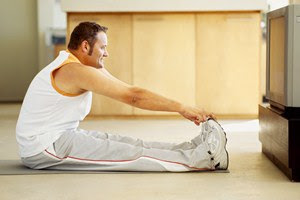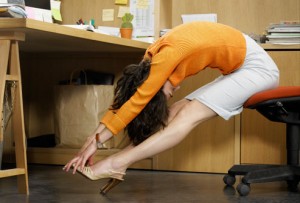Gentle Reader,
How flexible should I be? Should you be? It is amazing to me how much more flexible I am after a weekend Yoga retreat and 3 additional sessions with the instructors; more to come. But in no way do I lean to left or right as far as the others in the class. Nor can I make my shins line up on top of each other in that bent knee sitting position. I sit for opening and closing O-m-m-ms on a rolled up blanket to gain some height.
How flexible show we be? Dr. Pierre Dubois has some ideas that may help. He begins with asking, “How do you measure flexibility?
 “Watching a dancer her leg to her nose is an impressive sight, and many of us can perform similar feats when we’re children. But we begin to lose flexibility as we age if we do not make a conscious effort to remain limber.
“Watching a dancer her leg to her nose is an impressive sight, and many of us can perform similar feats when we’re children. But we begin to lose flexibility as we age if we do not make a conscious effort to remain limber.
“Inactivity causes muscles to shorten and stiffen, and muscle mass is lost with increasing years as well. However, maintaining flexibility as we get older is of great importance, since it allows us to retain our mobility and reduces the likelihood of aches, sprains and falls as we age.
“How Flexible Should I Be?
“Optimal flexibility means the ability of each of your joints to move fully through their natural range of motion. Simple activities such as walking or bending over to tie your shoes can become major difficulties if your flexibility is limited. Unfortunately, sitting for hours at a desk, as so many are forced to do on a daily basis, eventually leads to a reduction in flexibility as the muscles shorten and tighten.
Dr. Dubois suggests this simple Test For Measuring Flexibility
“There are a number of different tests used to measure flexibility, but the one test that has been used as a standard for years is the sit and reach test. It measures the flexibility of your hamstrings and lower back. The simple home version of the test requires only a step (or a small box) and a ruler.
In Seattle’s Pacific Science Center, there is an interactive exhibit in the Human Body room where you climb on a bench that is set up exactly as described here. I was interested in the flexibility range presented by my own 11 teen-aged grandchildren who were with me. The ones who move a lot in sports were more flexible. I expected that. What surprised me was the lower measure of flexibility in the ones who did not move very much in their everyday school life.
“Before the test, warm up for about 10 minutes with some light aerobic activity and do a few stretches. Then place the ruler on the step, letting the end of it extend out a few inches over your toes, and note where the edge of the step comes to on the ruler.
“Sit on the floor with your feet extended in front of you, flat against the bottom step (or box). With your arms extended straight out in front of you and one hand on top of the other, gradually bend forward from the hips, keeping your back straight. (Rounding the back will give you a false result).
“Measure where your fingertips reach on the ruler. They should ideally be able to reach at least as far as the front of the step. Any measurement past the edge of the step is a bonus. No matter how far you can reach on the first measurement, do the test periodically and try to improve your score every few weeks”.
Increasing Your Flexibility
“If you find that you are less flexible than you should be, some regular stretching exercises combined with visits to your chiropractor can help to restore flexibility and improve range of motion, helping to ensure that you remain limber into older age.”
The Bottom Line
• Optimal flexibility means a full range of motion for all of our joints.
• Age, inactivity and desk-bound work environments all can cause loss of flexibility.
• The sit and reach test is a good measure of flexibility.
• If your flexibility is not what it should be, do stretching exercises every day.”
I am convinced that with gentle, persistent and consistent effort, you can increase your flexibility and that in turn can decrease arthritis pain. I’d love to hear from you, so shoot me an email about how flexible you are.
Be well, Do well, and Keep moving,
Betsy
206 933 1889
